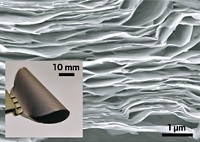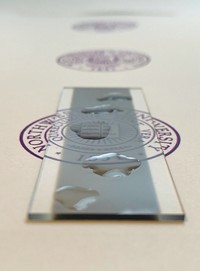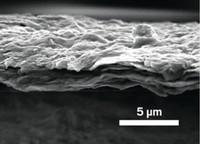Advertisement
Grab your lab coat. Let's get started
Welcome!
Welcome!
Create an account below to get 6 C&EN articles per month, receive newsletters and more - all free.
It seems this is your first time logging in online. Please enter the following information to continue.
As an ACS member you automatically get access to this site. All we need is few more details to create your reading experience.
Not you? Sign in with a different account.
Not you? Sign in with a different account.
ERROR 1
ERROR 1
ERROR 2
ERROR 2
ERROR 2
ERROR 2
ERROR 2
Password and Confirm password must match.
If you have an ACS member number, please enter it here so we can link this account to your membership. (optional)
ERROR 2
ACS values your privacy. By submitting your information, you are gaining access to C&EN and subscribing to our weekly newsletter. We use the information you provide to make your reading experience better, and we will never sell your data to third party members.
Materials
Electrodes Go For A Dip To Clean Water
Water Desalination: Electrode wires move in and out of brackish water to remove salts
by Katharine Sanderson
June 14, 2012

A cheap, simple way to remove ions from brackish groundwater has been developed, requiring little more than dipping carbon electrodes into salty streams (J. Phys. Chem. Lett., DOI: 10.1021/jz3005514).
In many of the poorest, driest parts of the world, access to fresh water is limited. As people deplete groundwater and dig deeper to reach aquifers, the water they pump out becomes more brackish. Most current techniques to desalinate water and make it drinkable are energy intensive and too expensive for impoverished, remote regions, says P. Maarten Biesheuvel of Wageningen University, in the Netherlands.
Biesheuvel and his colleagues found a possible low-energy method. They made wires out of carbon rods and coated them with porous carbon. Pairs of these wires acted as electrodes, one as a cathode and the other as an anode.
The team dipped the pairs in water they wanted to desalinate and applied a voltage to the wires. The charged electrodes attracted any ions in the water to either the cathode or anode. The ions stayed in the pores of the electrode while the voltage was on. The researchers then removed the electrodes, dipped them in a beaker of brackish water, and turned off the voltage to release the ions. They repeated the cycle five times to convert brackish water with a salt concentration of 20 mM to water with a salt concentration less than 10 mM, which the researchers say is potable.
Biesheuvel envisages splitting a running water source into two streams, and automating the dipping of the electrodes into them. One side would become less salty, while the other would become more concentrated. People could then dump the brine stream into the sea, he says.
The new technique is related to a known desalination method that separates ions electrochemically, called capacitive deionization. But the established method uses one water stream, and the electrodes stay still as they switch on and off to produce drinkable water and salty water. With each switch, just-produced clean water mixes with briny wastewater, leading to low desalination efficiencies, and high costs, says Biesheuvel. His method avoids this mixing problem by using the two streams. He calculates it could turn 80% of incoming brackish water into potable water.





Join the conversation
Contact the reporter
Submit a Letter to the Editor for publication
Engage with us on Twitter